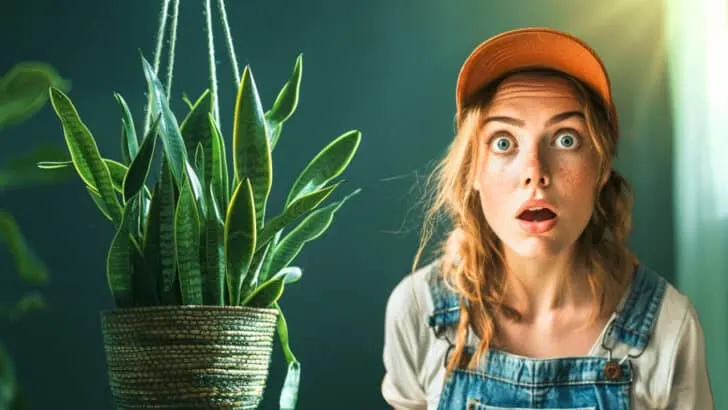There are only a small handful of houseplants that can be kept in hanging baskets while preferring low light conditions.
To make things easier, we’ve created a list of the top 35 candidates for hanging plants who enjoy low-light environments.
Let us have a look at each of these in more detail.
Best Hanging Plants for Low Light
- Pothos
- Heartleaf Philodendron
- ZZ Plant
- Chinese Evergreen
- Spider Plant
- Peperomia
- English Ivy
- Cast Iron Plant
- Silver Queen
- Rattlesnake plant
- Dumb Cane
- Blue Star Fern
- Monkey Leaf Plant
- Creeping Fig
- Maidenhair Fern
- Bolivian Begonia
- Marble Queen
- Ponytail Palm
- Silver Pothos
- Wax Begonia
- Donkey’s Tail
- Algerian Ivy
- Peacock Plant (Calathea Makoyana)
- Peace Lily
- Pinstripe Calathea
- Furry Feather
- Sword Fern
- Boston Fern
- Asparagus Fern
- Bird’s Nest Fern
- Rex Begonia
- Nerve Plant
- Wax Plant
- Prayer Plant
- Flamingo Flower
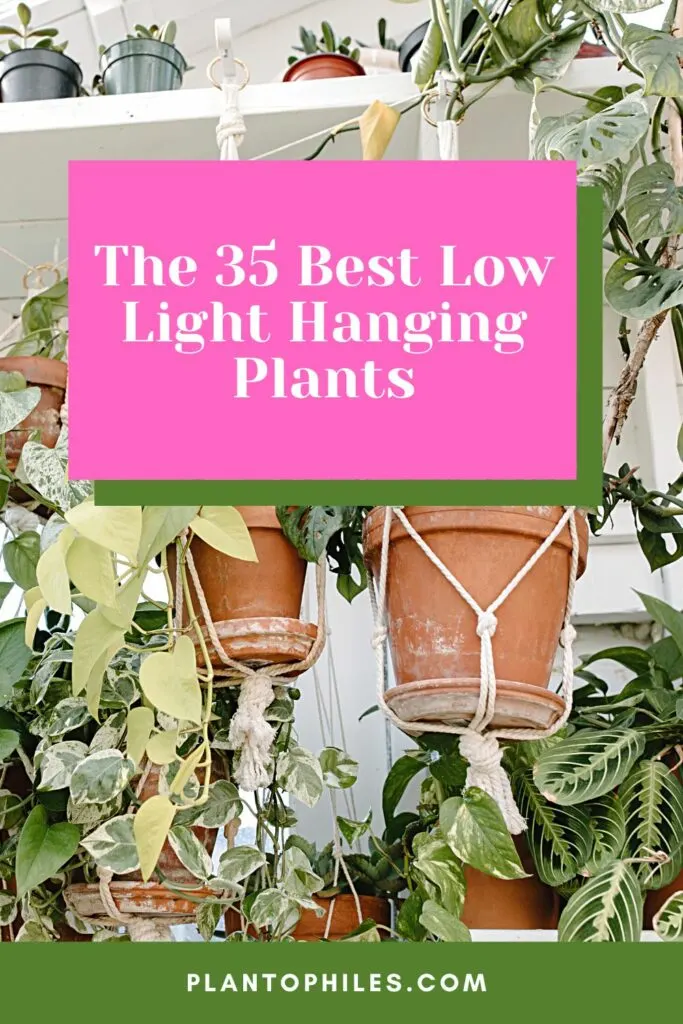
The Best Hanging Plants for Low Light
1. Pothos
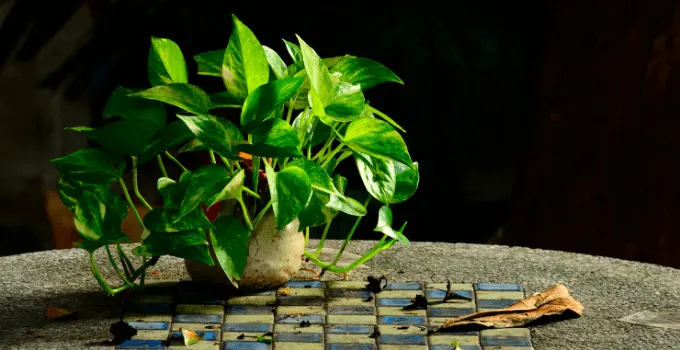
Pothos is a great candidate for anyone looking for a suspended flora with tolerances for low light levels.
They are well-loved houseplants for numerous reasons.
They’re easy to care for, purify the air inside your home, and last for quite a while. People are usually drawn to them for their various patterns and colors, all of which add a tropical flair.
Preferring low light places, you may want to take careful consideration as to where you’ll put them.
The bathroom or office tends to be the best spot, as they don’t have direct sunlight.
Find a windowsill in the house that you can set these plants on, preferably one that is directly exposed to the light.
When not pruned regularly, they become quite leggy.
Putting them into hanging baskets tends to keep the leaves out of the way.
Being able to grow along the wall is the perfect way to get enough sunlight without burning the leaves and halting growth altogether.
These plants make for a considerable addition to your home due to their resilient nature and overall preference for low-light settings.
They can survive in hanging baskets where their leggy stems won’t be stepped on.
Considering buying one of these tropical plants? Look over our Pothos plant care guide!
2. Heartleaf Philodendron
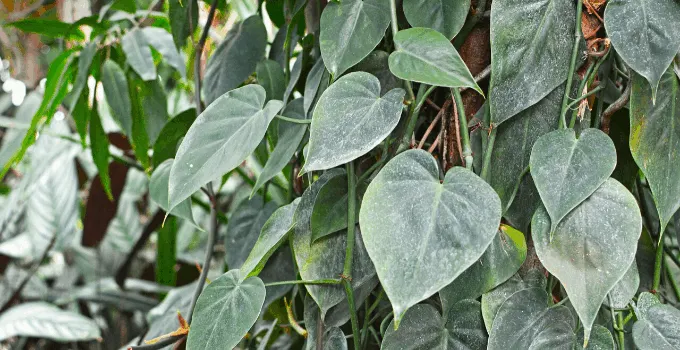
Also referred to as the Sweetheart Plant, the Heartleaf Philodendron is known for being sought out for its iconic heart-shaped foliage and its ability to grow quickly.
In fact, they do better indoors since the leaves have been known to dry out. They don’t need much water and can withstand a wide temperature range.
The Heartleaf Philodendron also can thrive when placed in an area with low light conditions, thus making it onto our list!
As for light, these plants can handle a mixture of levels. They do just fine with indirect or filtered light but can be just as happy in homes with low light.
The potential for an air plant means that you won’t have to worry about having it take up too much room.
The leaves themselves generally reach about two to four inches in length with the stems growing to be four feet long.
Most choose to place their Heartleaf Philodendron in the living room with a mixture of shade and indirect sunlight.
Direct exposure will have negative effects on the foliage, oftentimes resulting in yellow pigmentation.
Ideally, your Heartleaf Philodendron should be near an East or North-facing window for the best results.
Just be sure that the rays don’t make direct contact with the leaves for a long period of time.
We’ve added these floras to our list for their ability to handle low light levels, quick growth rate, and uniquely shaped foliage.
They do well when placed in hanging baskets, especially when in the living room.
Check out our article on Heartleaf Philodendron care for more information about this South American perennial!
3. ZZ Plant
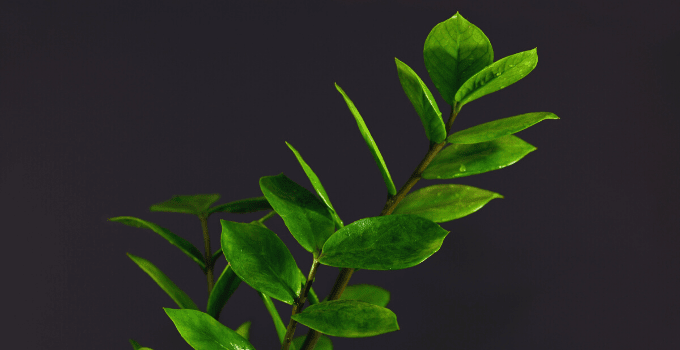
The Aroid Palm, or ZZ plant, may have an unusual name, but it has been known to make a fun addition to any home.
Their full name is “Zambioculcas zamiifolia”, hence the “ZZ.”
People are drawn to their dark green, large leaves that grow in feathery rows.
They are common plants for beginners!
Other than a good amount of water, this flora doesn’t really require much. This includes light. In fact, low light levels are preferred.
Although they do just fine when placed in a room with bright or moderate amounts of light, lower levels is more ideal. Those large leaves can be susceptible to scorching.
The best locations for an Aroid Palm tend to be the bathroom or the office.
This is where there will be smaller doses of sunlight. They are fairly quick growers, reaching a height and width of four feet.
Placing them into a basket allows them to grow out those long stems without the risk of being cramped in a corner.
We recommend finding a window that orients to any direction except for the South, as there tends to be harsher light found there.
You should also keep in mind that complete shade has negative impacts as well. They can thrive in low light levels, just not any sunshine altogether!
Having “palm” in the name, you might assume that the ZZ plant might need plenty of sunshine.
This isn’t necessarily true, making them a top option for one of our seven best hanging plants for low light. This is due to their responsiveness to growing off the ground with only minimal light!
Want to know more about the care involved in having your own Aroid Palm? Check out our article on the ZZ plant.
4. Chinese Evergreen
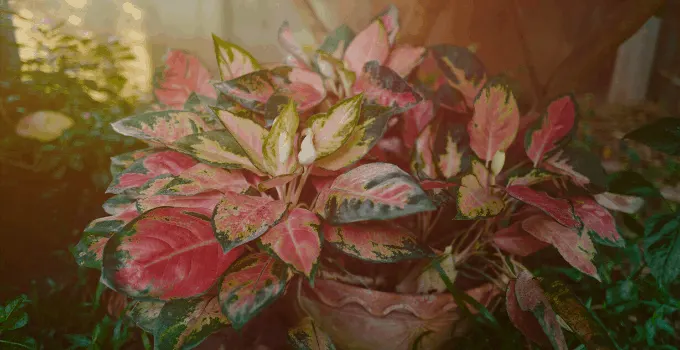
Flowering plants, such as the Chinese Evergreen, tend to need a bit more care compared to other flora.
Most who pursue these individuals do so because of their bright foliage, bringing a sense of tropical forest to your home.
Although they prefer to have a moist environment, they can thrive in settings with filtered, or lower levels of light.
The most classic way to decorate your home with a Chinese Evergreen is to place it into a somewhat large pot and leave it on the top of a table.
This might seem just fine for a younger plant, but once they are fully grown, the leaves measure about five to eight centimeters in width with a length of thirty centimeters.
You can opt to place them into a hanging planter in the bedroom or bathroom.
The trick for these plants is that they do not do well when sitting in direct sunlight, so avoid areas with large windows.
Rooms that have no windows aren’t an issue for the Chinese Evergreen! They’re more than prepared to handle little to no light.
Don’t let their watering requirements dissuade you from adding a Chinese Evergreen to your home.
These plants are relatively easy with a preference for poorly lit areas.
They also can be kept out of the way so that you don’t have to worry about those large leaves taking up too much space!
We have an article dedicated to the overall well-being of the Chinese Evergreen plant.
5. Spider plant
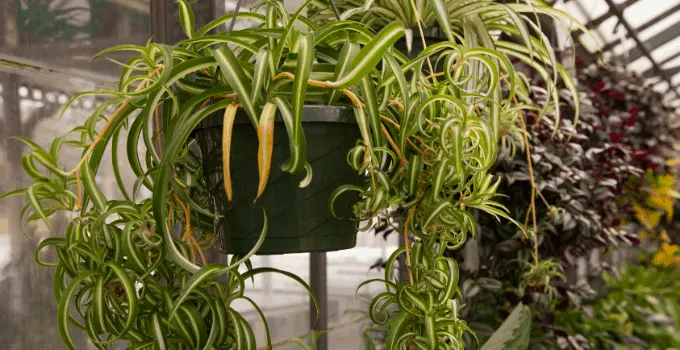
Named for their grass-like leaves, these herbs make for quite the statement.
They don’t require a lot of care, thriving and growing in minimal action on your part.
Better yet, they even purify your home’s air!
Despite their preference for bright light, they’ve made their way onto our list because it’s better to place them into a room with low light levels.
Their tendency to grow with those long leaves hanging down makes them a great contender for hanging baskets.
Spider plant owners will place these individuals in a part of the house that gets anything from partial shade to bright, indirect sunlight.
The only problem with more extreme exposure to the sun is that the leaves can start to wilt.
Hanging baskets tend to offer a bit more shade, especially if you’re careful about the location.
We suggest growing your Spider plant in the bedroom since they oftentimes have lower levels of light.
Avoid putting them into any windows that face the South.
The most beneficial spots would be ones that face either the East or the North.
It isn’t merely the rays beating down on the foliage that causes damage. It’s also the heat.
Succulents have grown in overall popularity in more recent years, mostly due to their hardy nature.
The Spider plant is no outlier, only needing the essentials.
Their leaves are best showcased in a hanging container for all to see!
You may be apprehensive about the leaves wilting, which is why poorly lit spots are ideal!
So make sure that you keep this low-light draping plant in a spot where it does not get too much exposure to sunlight!
Looking for a guide about these succulents? Read up on our Spider Plant Care 101!
6. Peperomia
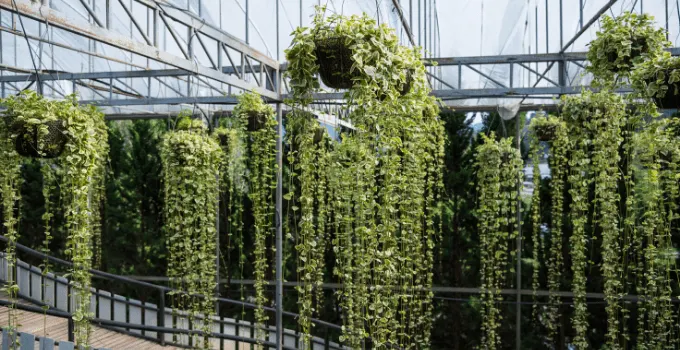
The Peperomia plant is known by many names.
Some of these include the Baby Rubber plant, the Pepper Elder, the Radiator plant, and the Shining Bush plant.
They are well known for being an easy keeper that doesn’t grow to be too large.
Not all Peperomia plants are able to cope in conditions with low light levels, though a good number of them can!
Their small, patterned leaves are easier to be shown when kept in hanging baskets.
Where you keep your Peperomia plant will depend on which variety you have. They prefer warm areas with relatively high humidity.
A bathroom is a perfect place for these individuals since they have a good amount of moisture in the air while not having as much light.
The one thing that they can’t stand is bright, direct sunlight.
This is why it makes more sense to play it safe with a low-light area!
If you’re not a fan of keeping them in the bathroom, consider finding a window that faces the West or East.
These tend to have enough indirect light to make your Spider plant happy.
You can also choose to provide your own rays through fluorescent lighting.
Sporting attractive spots and veins along their leaves, Peromia plants are a great addition to any home.
They’re considered to be somewhat easy to care for, thriving in several environments, including low light.
Opting to place them inside a hanging basket can be a great way of showing them off.
Consider reading our Peperomia guide for more tips to keeping them that rich, vibrant hue!
7. English Ivy
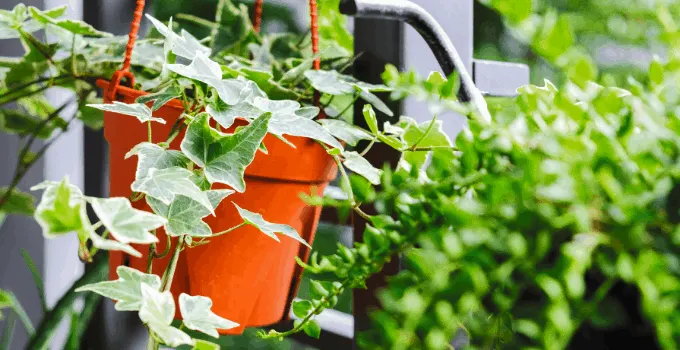
Not to be confused with Poison Ivy, these individuals make for great indoor additions.
In fact, they are quite popular, especially in Europe.
With the right attention, they make for an ideal air plant with cascading stems and leaves.
Living in poorly lit areas is no big deal since the opposite conditions can lead to dying foliage.
All of these factors have placed them on our top list of low-light-loving hanging dwellers.
The natural habitat of English Ivy includes densely populated woodlands.
Given these conditions, it’s fair to infer that they do quite well in places with lower light levels. To be honest, they prefer it!
The most common spot where you’ll find English Ivy is in the living room where it is hung from a basket.
Keep in mind that those stems can reach up to 15 feet in length. Give them lots of room to spread out!
As for where to put them, West-facing windowsills work quite well.
Having a cascading plant to adorn your living room or bedroom is a fun way to add personality to your home!
The English Ivy is a great indoor houseplant due to its overall versatility.
It can grow in low-light areas and thrive off the ground in a basket.
We have an article devoted to the care of your future English Ivy!
The fact of the matter is that you don’t need to have lots of light in order to have fun houseplants.
There are plenty of individuals that will tolerate poorly lit rooms.
We also understand that you may want more plants than you have room for.
The easiest fix for this problem is to find a flora that is fine being placed into a hanging basket.
All of the plants in this article are more than able to survive suspended in a basket while being placed in a room with low light levels.
That way, you can have your houseplant fix without worrying too much!
The Best Hanging Plants that Don’t Need Sun
If you love the jungle aesthetic that hanging houseplants create but are struggling to find a plant for a particularly dark corner, you’ve come to the right place.
If you want to hang a plant in a room that doesn’t get much sunlight, you have a variety of options.
Even if the room you want to hang a plant in is basically totally dark, you can still dress it up with living greenery. All you have to do is choose one of the best houseplants for growing under artificial light and get an appropriate grow light.
Here is a wonderful selection of hanging plants that don’t need the sun to thrive.
8. Cast Iron Plant
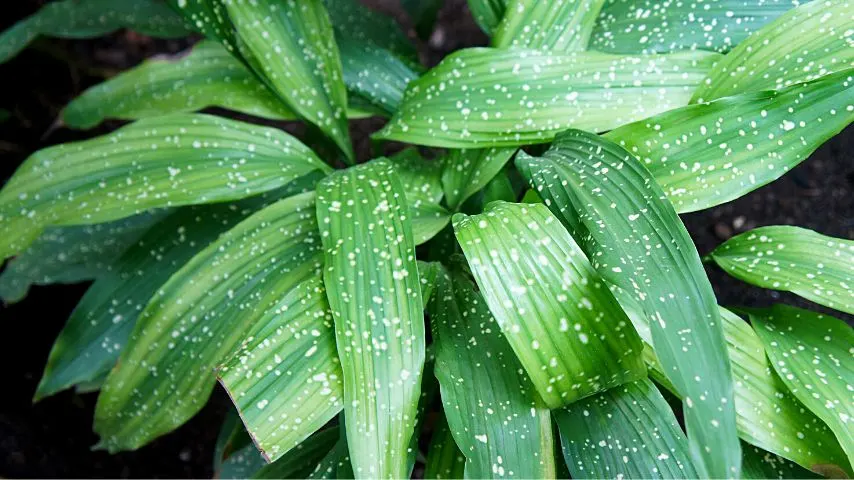
Cast iron plants make wonderful hanging plants. While they don’t quite trail down via vine-like stems, their glossy, dark green leaves have an elegant cascading look.
You’ll be glad to hear that cast iron plants have a reputation as difficult-to-kill houseplants. They like shade and are not fans of direct sunlight. In fact, cast iron plants can survive with almost no sunlight at all.
As long as there is a window in the room you’re placing your cast iron plant, you should be good to go. Check out this article for some excellent cast iron care hacks.
9. Silver Queen
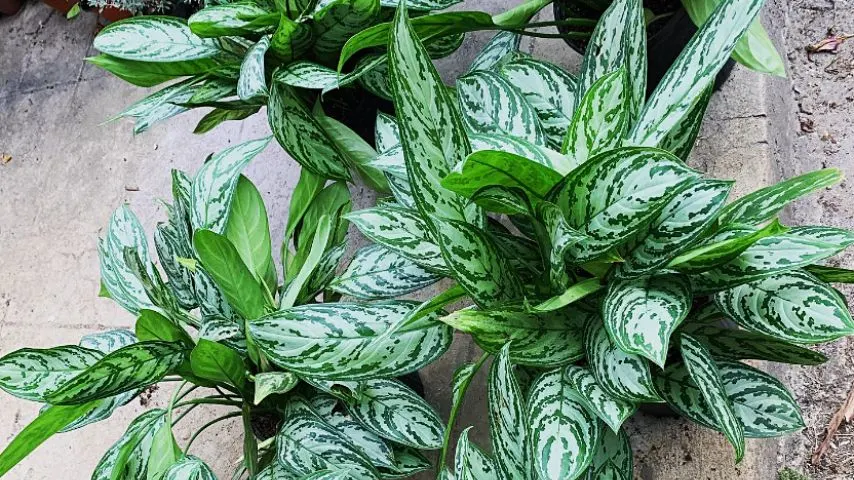
Silver queens are as regal as their name suggests. This Chinese evergreen variety has luscious, white-patterned leaves that grow in a downward direction.
While silver queens do not trail or cascade, their long, marbled leaves do grow over their planter’s edges.
Silver queens are excellent air purifiers, which is just an added bonus.
When it comes to light, silver queens aren’t picky. They don’t like direct sunlight, but other than that, they can generally survive anywhere, if they are getting some indirect light.
10. Rattlesnake Plant

Rattlesnake plants are a gorgeous calathea variety. Their long, thin leaves are ridged and marked with dark green spots in a pattern that resembles a reptile’s skin.
They are an excellent plant choice to put in a hanging pot because they are so eye-catching.
Growing a rattlesnake plant involves keeping the room temperature warm and the plant’s leaves and soil gently moist. Rattlesnake plants, or calathea lancifolias, are so focused on their humidity requirements that light becomes an afterthought.
Native to the Brazilian rainforest, these slender-leaved beauties care much more that their environment is moist and relatively warm than about the amount of sunlight they get.
Because they generally grow on the forest floor, rattlesnake plants cannot handle direct sun. Growing them in a shady corner would be perfect.
Like their fellow calatheas, rattlesnake plants like indirect light and do quite well in shade. Their long leaves can photosynthesize without direct sunlight.
That being said, these plants are moderately difficult to care for. Before you make the jump and commit to buying this calathea, read up a bit more on how to care for a rattlesnake plant.
11. Dumb Cane
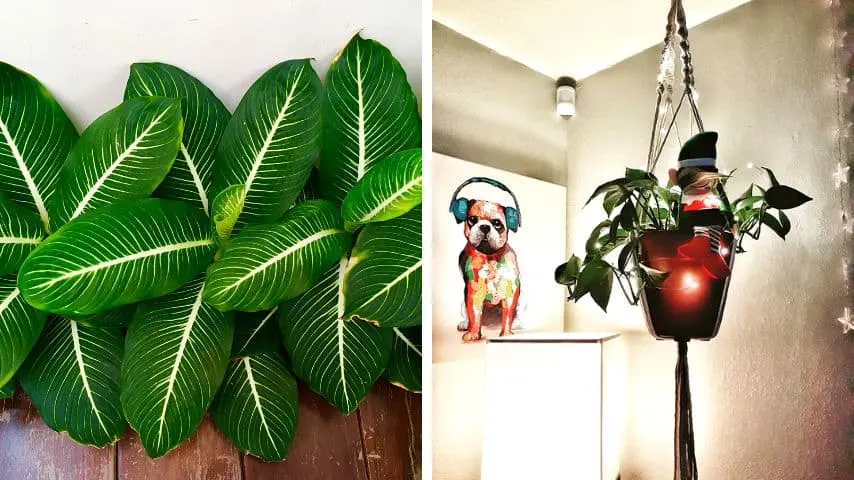
Fortunately, these plants are a lot more beautiful than their name suggests. Dumb canes, or dieffenbachia, come in a wide variety of cultivars.
From melon-colored honeydews to marbled compactas to variegated camilles, there is no shortage of lovely dumb cane varieties.
In addition to having gorgeous, luscious foliage that looks great in a hanging pot, dumb canes are also easy to care for. They can thrive in anything from low light to high light conditions.
Dumb canes have medium water needs, and they also purify your air. What’s not to love?
12. Blue Star Fern
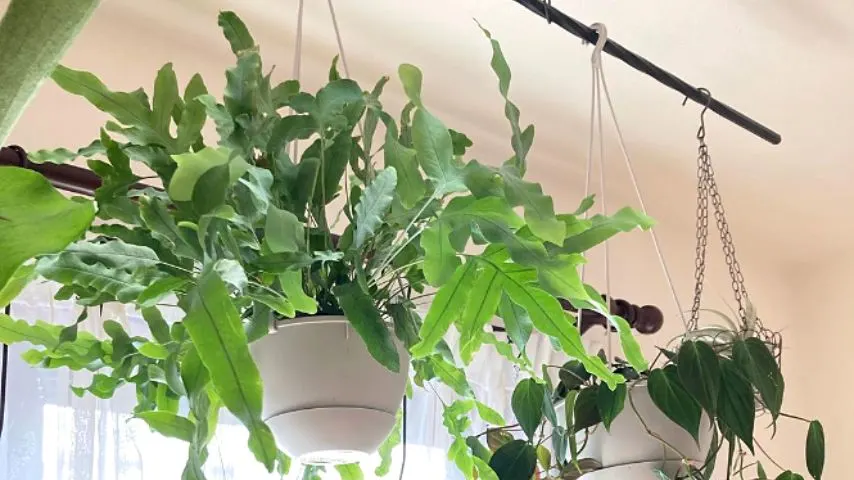
Blue stair ferns don’t look like the image that probably pops into your mind when you hear the word “fern.”
These tropical ferns have dainty stems and paper-like blue-green leaves. These epiphytes are native to the Amazon rainforest and can be found growing on trees, like a kind of moss.
Since they enjoy living up in the forest canopy, raising them up off the ground in a hanging planter is a great way to return them nearer to the height they usually grow at.
They do not like direct sunlight and should be hung in a shady spot that gets a bit of indirect light.
Make sure you keep the room they are growing in relatively humid, and don’t let their soil dry out completely between waterings.
The Best Low Light Trailing Plants
There is something particularly breathtaking about entering a room full of hanging, trailing plants.
Wondering what the difference between a hanging and a trailing plant is? Well, a hanging plant is basically any plant that has been placed in a hanging pot.
You can use macramé hangers to transform any pot from a standard to a hanging one, or you can purchase any number of different styles of planters or baskets that dangle down from the ceiling.
For example, even though succulents generally aren’t trailing plants, you can use one of these succulent hanging planters to give them a different role in a design concept.
Trailing plants have long, trailing stems. Their leaves hang down beautifully, and they grow downward as they grow longer.
Most owners of trailing plants like to display them in hanging pots, or in pots on shelves, allowing the cascade of their greenery to be on full display.
If you want to achieve this look in a room with low light, here are some of the best low light trailing plants to buy.
13. Monkey Leaf Plant
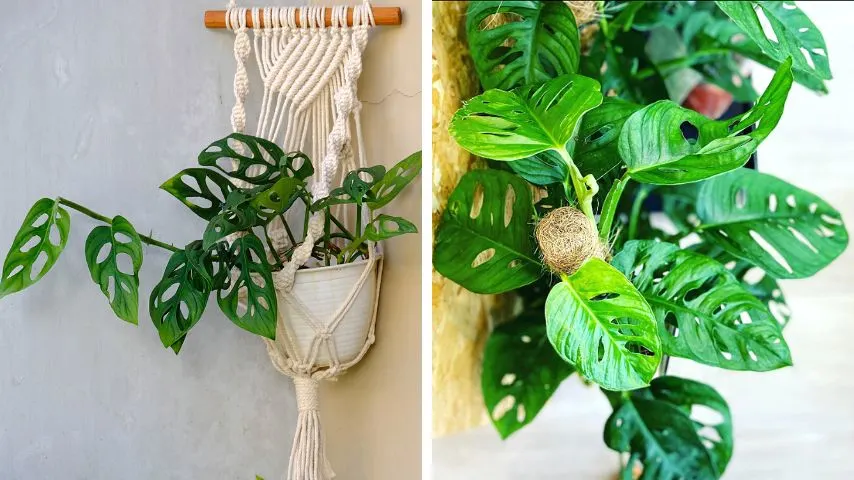
If you want a plant that gives off “I’m fun and quirky” vibes, you’ve come to the right place.
These playful, vining beauties resemble a combination of a monstera and a heart-leaf philodendron. And fortunately, they are pretty hardy.
Caring for a monstera adansonii, also known as a Swiss cheese vine or monkey leaf plant, is relatively easy. Make sure you keep it in a relatively humid environment and give it indirect light. Don’t let it soil dry out completely between waterings.
Once this unique, holey vine grows long enough to trail below a hanging planter, you’re in for a serious treat.
14. Creeping Fig
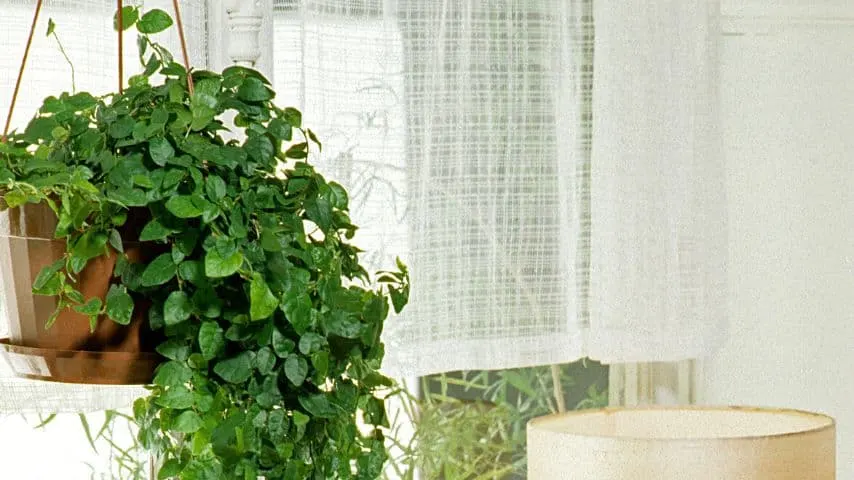
If you’ve been searching for a trailing, hanging plant that can tolerate low light conditions, you’ve probably heard lots about pothos and philodendron varieties.
However, a wonderful option that you probably haven’t stumbled upon yet is the creeping fig. This member of the ficus family has tiny, dainty leaves that grow down along vine-like stems.
Over time, its stems will drape down in a beautiful cascade, making them an ideal plant choice for a hanging basket.
15. Maidenhair Fern
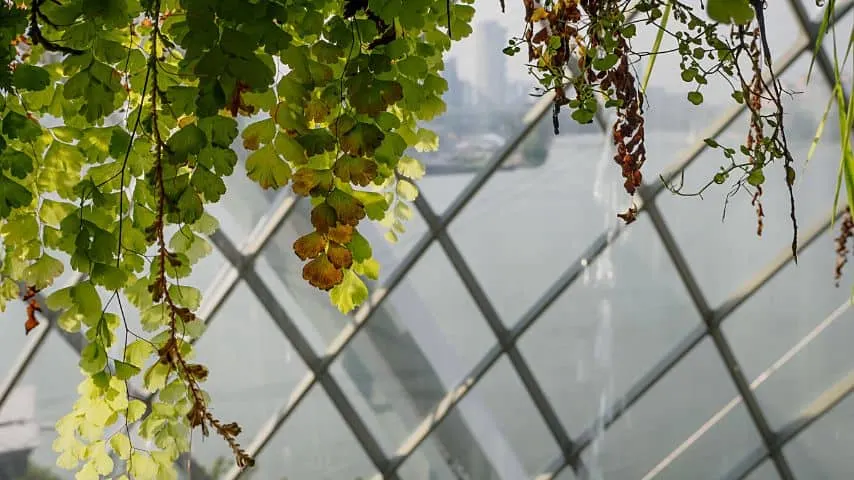
These dainty woodland dwellers grow in fronds of fingernail-sized leaves connected by tiny stems.
Maidenhair ferns do not like direct sunlight and make a wonderful cascading addition to a room with low light.
While they are ferns and not vining plants, their fronds grow downwards, and the plants have a trailing look.
If you’re looking for a trailing plant to grow in low light conditions, look no further than the Bolivian begonia. This plant was basically designed to be grown in a hanging basket.
16. Bolivian Begonia
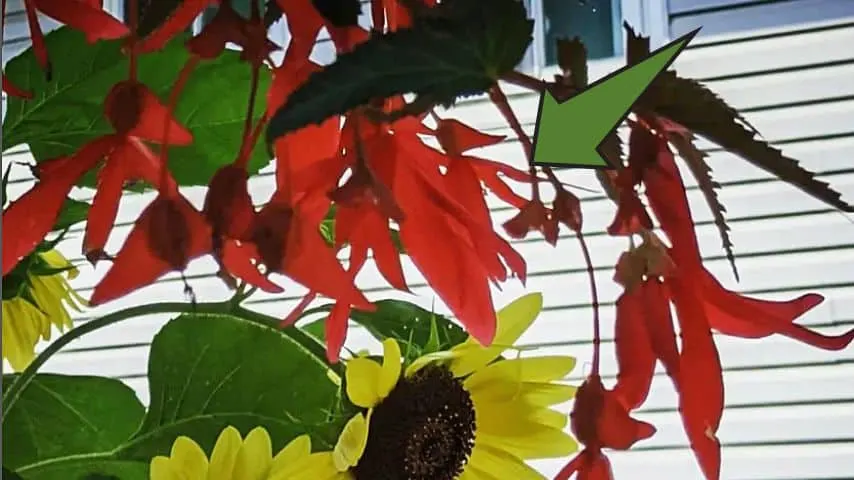
It can grow in highly versatile conditions, including shady spots, and its bright flowers put on an epic show when they bloom all throughout the long summer season.
These plants will flower from late spring until early fall if cared for well.
The Best Low Light Cascading Plants
17. Marble Queen
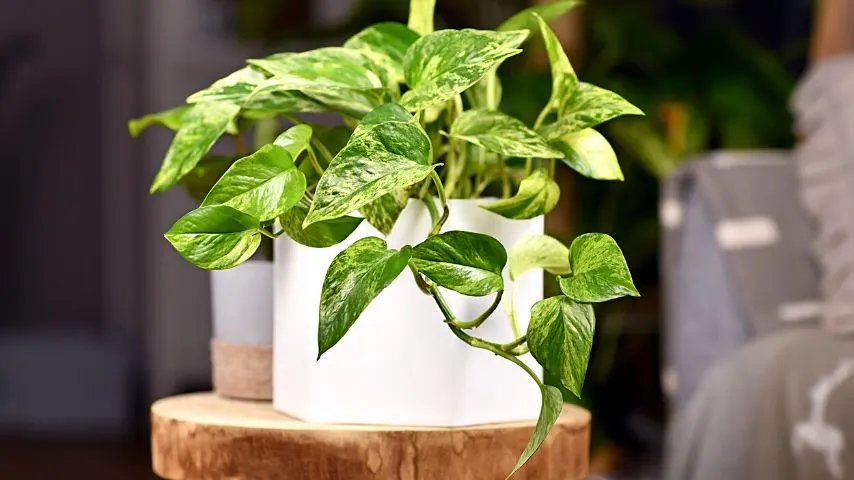
Marble queens are one of the pothos varieties you should know. Their gorgeous, white and light green marbled leaves are thinner than those of the standard golden pothos.
As a result, they are more sensitive to light than their yellower counterparts.
All pothos plants are notoriously hardy plants that can survive less-than-ideal conditions. That said, a pothos won’t grow if it doesn’t get at least a bit of indirect sunlight.
In addition to being low maintenance, marble queens are vining plants that can put on a beautiful cascading display when you grow them in a hanging pot.
If you are growing a hanging pothos in low light and are wondering “why is my pothos wilting?” you may need to move it to a sunnier location temporarily.
After it has done a bit of sunbathing in bright, indirect light, you can return it to its shadier location.
18. Ponytail Palm
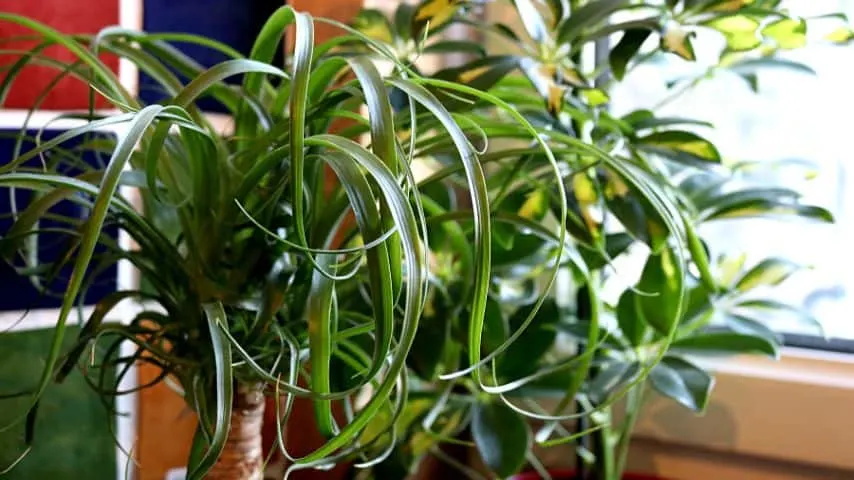
If you’re confused about how a palm tree could be a cascading plant, you’re in for a surprise!
Ponytail palms are sturdy little trees with long, elegant fronds that grow downwards.
Their shape resembles a weeping willow more than your typical palm tree. Growing a ponytail palm in a hanging planter can yield a beautiful cascade of dainty fronds.
If you eventually decide the dangling fronds aren’t for you, you can always look into how to trim and prune a ponytail palm.
While ponytail palms do need indirect sunlight, they are sturdy plants and can usually tolerate low levels of light.
If you notice over time that your fronds are looking a little worse for wear, you can always give your palm a “vacation” in a room with a south-facing window.
19. Silver Pothos
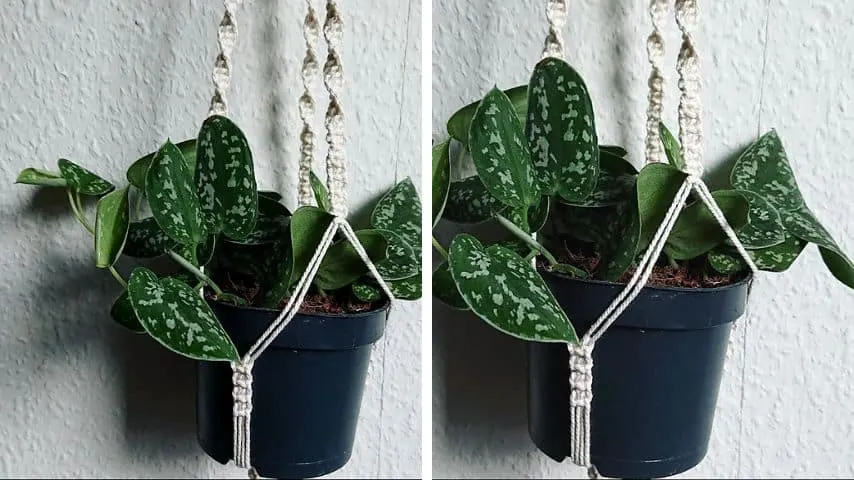
This gorgeous pothos variety offers up a shimmering cascade of light-catching leaves. Pothos plants only need indirect light and are extremely low maintenance.
Silver pothos can grow vines up to ten feet long, which makes it an ideal thing to plant in a hanging pot.
20. Wax Begonia
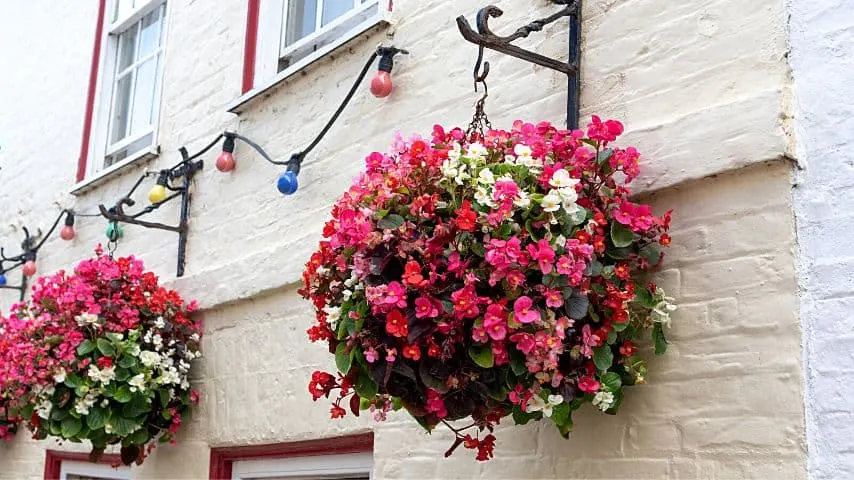
If you’re looking for a flowering cascading plant that you can keep indoors during the winter months and move outside in the spring and summer, you’re in luck!
Wax begonias look gorgeous when their leaves grow down over the edge of a hanging planter. Their pink blooms add some wow factor to their bushy, waxy leaves.
They do well in partial shade and can quite happily live under the cover of an awning.
They don’t give you the same kind of cascade as a pothos does, but if you select a small planter that allows the flowers to dangle over its edge, you won’t regret it. Once your pink flowers are in full bloom, you’ll see why hanging up these woodland wonders is a fantastic idea.
21. Donkey’s Tail
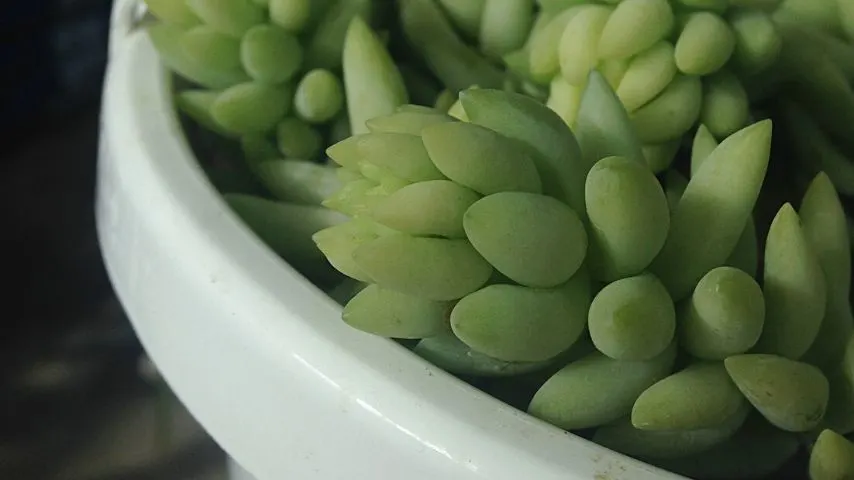
They don’t give you the leafy, vining look of ivy, but donkey’s tail succulents certainly do hang down.
Their bulbous, snake-like stems can grow in bright shade and reach up to four feet in length.
Take a chance on this cascading succulent with fleshy, bulbous leaves if you’re looking for an unusual low light hanging plant.
22. Algerian Ivy
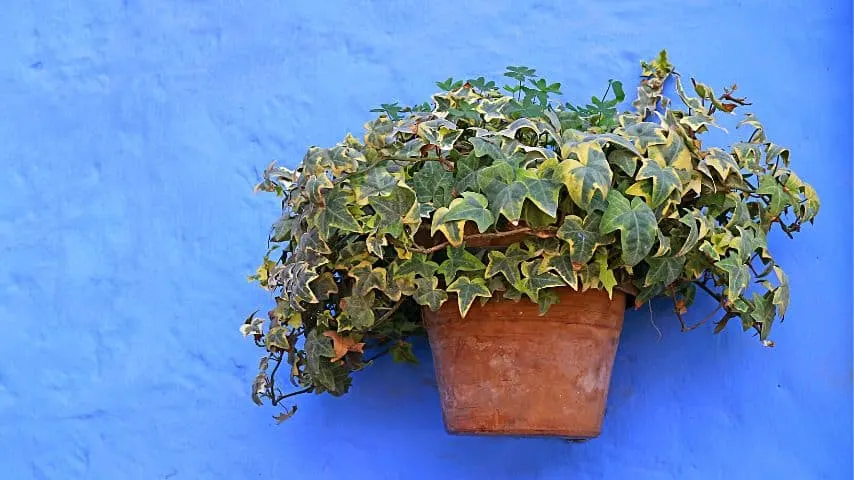
Algerian ivy likes full to partial shade. In fact, bright sun can stunt its growth. This unique ivy variety features a white and green marbling effect and looks magnificent, dangling down from a hanging pot.
Because it is native to the southern hemisphere, it is pretty drought-tolerant. It requires minimal care and is just an all-around unfussy houseplant.
If ivy starts losing leaves, check out all the possible reasons before jumping to the conclusion that a lack of sunlight is responsible.
As long as you aren’t keeping it locked in a dungeon, Algerian ivy should grow just fine.
The Best Indoor Hanging Plants That Like Shade
If you’re looking for an indoor plant that is partial to shade, you can opt for plants that grow beneath the canopy of the rainforest.
These forest-floor dwellers tend to have copious wide, flat leaves that allow them to absorb the small amount of sunlight that filters through the leaves of the canopy. This makes them ideal plants to grow in shadier areas of your home.
The calathea family does particularly well in shady environments. Calathea leaves also know how to put on an admirable display, which makes them the perfect plants to grow in hanging pots.
23. Peacock Plant (Calathea Makoyana)
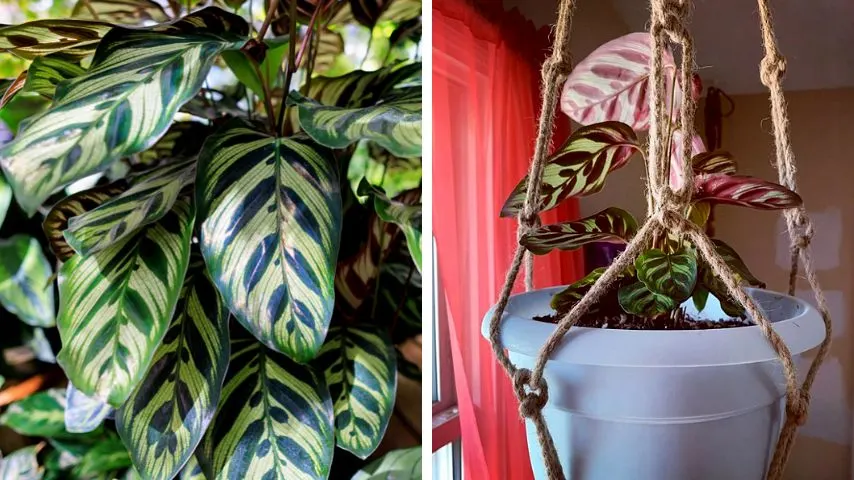
If you need calathea makoyana care explained, look no further. Peacock plants need indirect light, and their leaves may burn if they receive too much direct sun.
They need to be potted in well-draining soil, which should be kept gently moist.
Calatheas are more sensitive to deviations in temperature than to low light levels, so make sure you keep them in a warm environment (between 65- and 85 degrees Fahrenheit).
24. Peace Lily
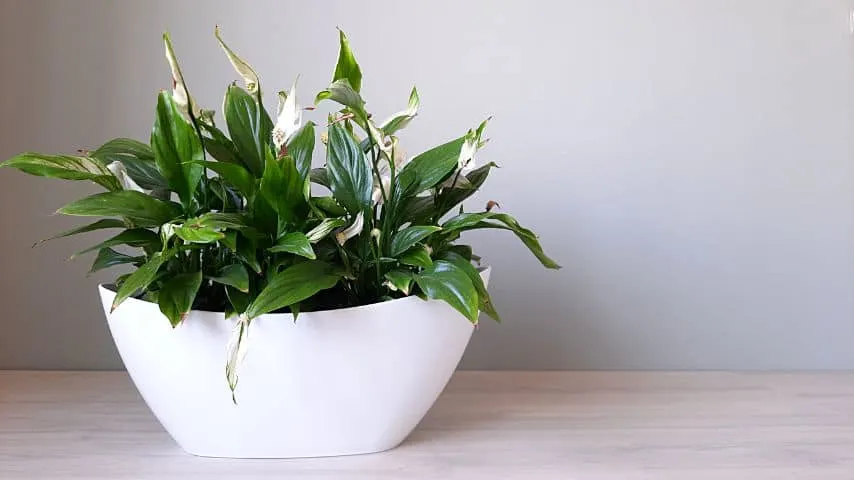
Nothing hurts a plant-lover more than seeing a sunburned peace lily.
These delicate plants have fragile leaves and paper-thin white flowers that appear in the spring and can last for over a month. If they are cared for particularly well, they sometimes grow flowers again in the fall.
Taking care of a peace lily plant requires attention to detail. They certainly aren’t as low maintenance as some of the other plants featured in this article.
However, as long as they are getting low levels of light and some indirect sun, you can rest assured that their light requirements are being met.
25. Pinstripe Calathea

Pinstripe calatheas have thin pink or white pinstripes on their wide, rounded leaves. Like most calatheas, they have straight, tall stems and grow upwards and outwards.
Because their young growth tends to pop up around the perimeter of the plant, pinstripe calatheas form wonderful, bush-like shapes and look excellent in a hanging planter.
Native to jungles, calatheas are used to shade. In fact, they will dry out and their leaves may burn and curl if they are placed in direct sunlight.
26. Furry Feather

This unusually named calathea looks exactly how its name suggests it would. It has long, feather-like leaves that have a fuzzy quality.
If you run your hand along the leaf of a furry feather with your eyes closed, you could almost believe you were petting an animal.
Furry feathers prefer shade to direct sun and can tolerate low light conditions.
Growing them in a hanging planter puts the gorgeous magenta of their stems and leaf undersides on display.
The Best Low Light Hanging Plants for Bathrooms
Bathrooms are generally moist environments. The steam from showers, baths, and sinks is excellent for houseplants.
However, even though their damp, warm character gives bathrooms an advantage when it comes to growing houseplants, a lot of bathrooms are relatively dark.
That said, don’t let the fact that your bathroom only has a small, glazed window put you off your dream of an Instagram-worthy shower experience.
If you’re looking for a low-light hanging plant for a bathroom, there are plenty to choose from. (Incidentally, if you’ve been reading this article and aren’t quite sure what all the light terminology means, here is an explanation of how light levels for plants work.
If you notice a theme among the coming recommendations, it’s for a simple reason: Ferns are wonderful bathroom plants. And the fact that they also happen to be one of the best houseplants for air purification is just an added bonus.
Choose from one of these excellent low-light plant options to give your bathroom a glow-up and make it feel like your own personal spa.
27. Sword Fern

The sword fern is so-called because of its sharp, straight fronds and equally pointy leaves. This traditionally shaped fern is hardy and can grow in a wide variety of light conditions.
The most important thing when it comes to caring for a sword fern is that you give it enough humidity. A sword fern will thrive if it is allowed to hang near a shower.
28. Boston Fern
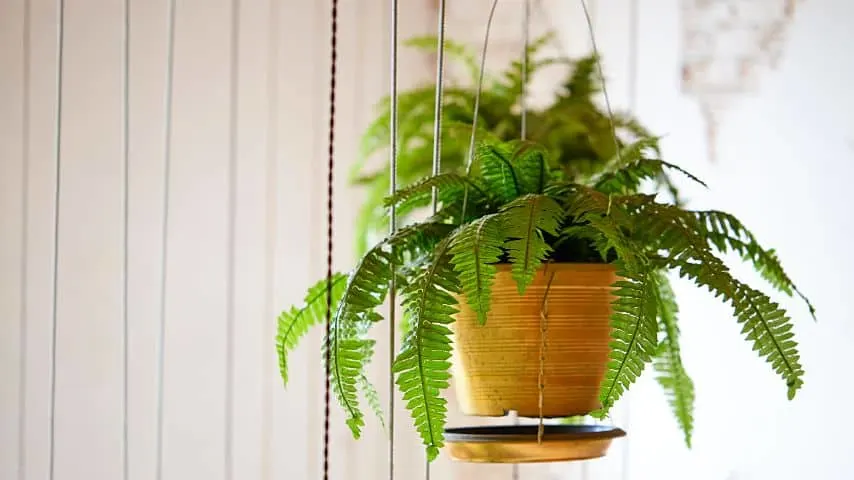
This classic fern is probably what comes to mind when you hear the word “fern.” Its light-green, delicate fronts and speckled, curling leaves look stunning in a hanging pot or basket.
Boston ferns do best in medium light but can tolerate low light, provided they still get a little bit of indirect sunlight.
29. Asparagus Fern
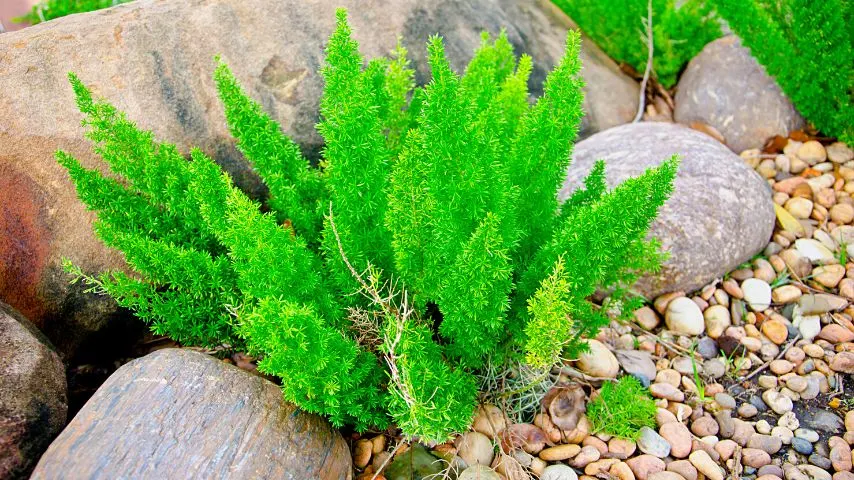
Asparagus ferns are incredibly delicate plants. Their thin stems and even thinner fronds look wonderful in hanging pots. They love humidity and warmth and are happiest in damp environments.
If you have space to place hang an asparagus fern in your bathroom, go for it! They can survive in lower light conditions and do well under artificial light too.
Plus, if you notice their ends turning brown, you can always relocate them to a place with more indirect sunlight for a week or so before returning them to the bathroom. Doing this once a month will ensure they get more than enough light.
30. Bird’s Nest Fern
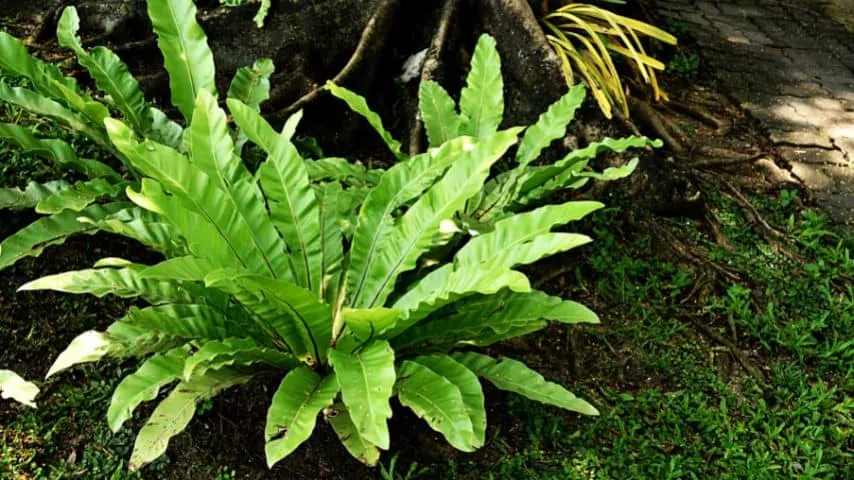
This wonderful fern has unfissured leaves that grow outwards from its center and curl at the end, giving it the appearance of a nest.
It looks hardier than most ferns, and it is. It can tolerate low light conditions and loves humidity, making it the perfect hanging plant for a bathroom that gets minimal light.
The Best Hanging Plants for Dark Rooms
We would all be more than happy to live in one of those modern, TV-ready, windows-for-walls houses. Unfortunately, they cost a pretty penny, and most of us have to accept living in rooms that aren’t always flooded with light.
The good thing is that no matter what your living space looks like, you always make it feel fancier and more expensive by adding a bit of greenery. Hanging plants do a great job of making rooms feel luxurious.
To find a hanging plant for a dark room, look no further. Here are some excellent options.
31. Rex Begonia
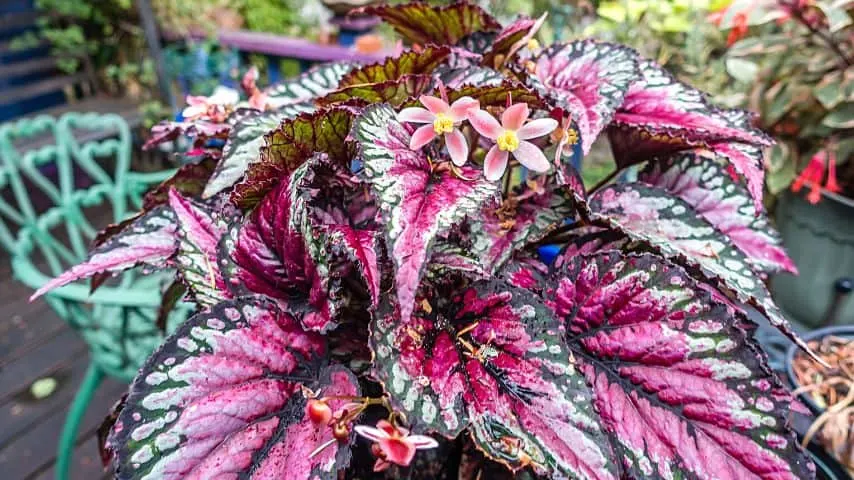
Rex begonias are real showstoppers. If you’re looking for an attention-grabbing plant to hang in your home, you can’t do much better than this variegated begonia variety. Their large leaves are like a living firework display: think shades of red, silver, green, and purple.
It doesn’t hurt that caring for a rex begonia is relatively straightforward.
They thrive in partial to full shade and do not like direct sunlight, which burns their leaves. This makes them the perfect choice for a hanging plant to grow in a dark room.
32. Nerve Plant
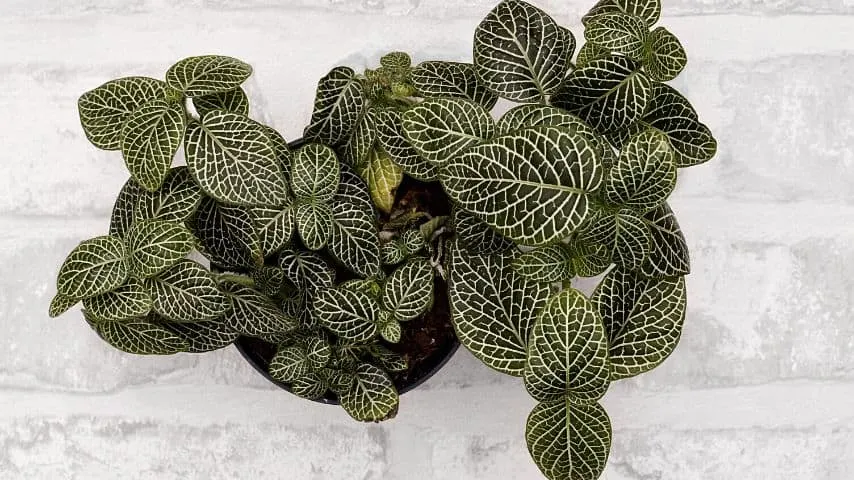
Some people like big, showy plants with plenty of foliage. However, if you are more of a minimalist, you might appreciate the subtle beauty of nerve plants.
These plants do just fine in low light and have small leaves that are crisscrossed with thin, vein-like lines. They take a while to grow, but once their elegant stems reach out over the edge of your hanging pot, you’ll be blown away.
If you notice the leaves curling on a nerve plant, don’t immediately assume it is because the room is too dark. Nerve plants generally do well in shaded environments, and their leaves are prone to burning if they get too much sun.
If you do think your nerve plant isn’t getting enough light in the dark room you’ve hung it in, you can always invest in a grow light.
33. Wax Plant
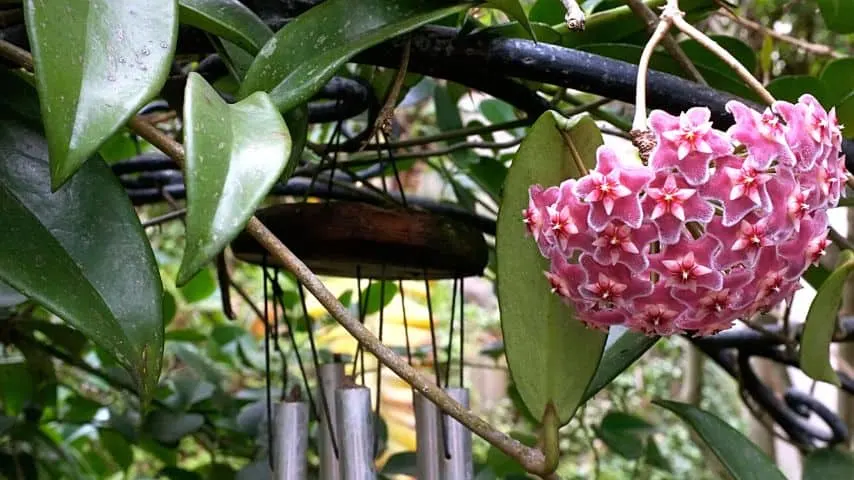
There is an old adage among horticulturalists that “the thicker and darker the leaf of a plant is, the hardier it is.”
And this does seem to hold true for a lot of houseplants. Wax plants get their name from their wax-like leaves. These retain water, which makes them thicker than most leaves and gives them a glossy sheen.
Also known as hoyas, wax plants like indirect light and aren’t fans of direct sunlight.
They are slow growers, but once their thick leaves have begun to cascade down over your pot’s edge, you’ll see why they make an excellent hanging plant.
34. Prayer Plant
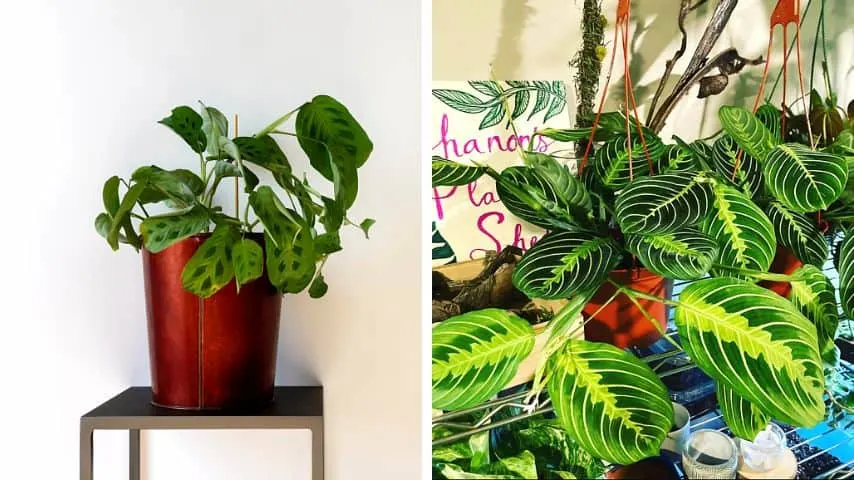
Prayer plants are known for their habit of curling up at night and unfurling again in the daytime.
Hanging them up allows their daily sun salutation to be put on full display.
Native to the rainforests of South America, these tropical plants typically grow on the rainforest floor and, therefore, don’t do well in direct sunlight.
35. Flamingo Flower
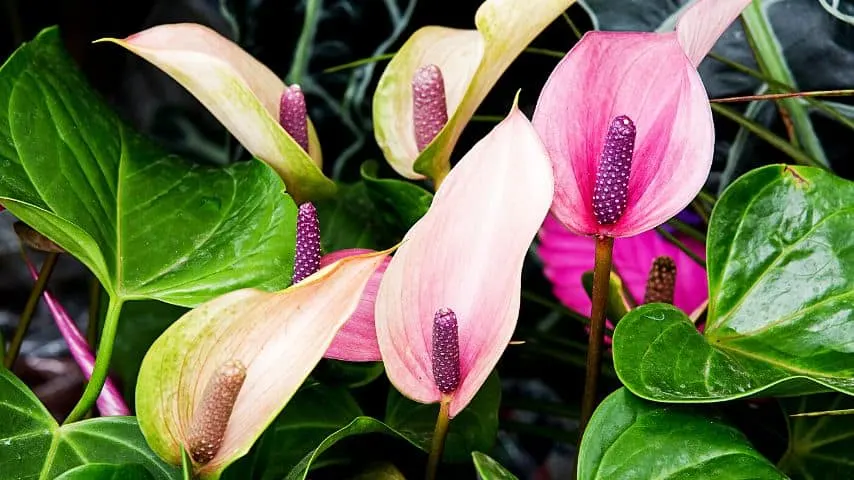
These delightful plants have long, straight stems, waxy leaves, and bright, glossy flowers that last for up to eight weeks at a time when cared for properly.
Their beautiful colors look wonderful when displayed in a hanging pot.
These anthurium flowers like moisture. In the rainforests they are from, they usually grow out of holes or crevices in tree trunks. Because they are used to being covered by the tops of trees, they don’t like direct sunlight.
Generally, they should do just fine living in a moderately dark room. However, do make sure you take them out to a spot with bright, indirect sunlight every so often to give them a little vacation.
This will make sure they meet their light quota and will keep them going.
What is low light exactly?
Low light is defined as a light intensity between PPF: 50-150 umol m-2s-1 or 50-250 foot candles, according to the University of Minnesota.
The University of Florida adds that our eyes are not a good judge of how intense the lighting is in a specific space as our eyes are constantly adjusting to different lighting conditions.
Dark spots might seem brighter than they actually are.
Based on personal experience and measuring with different light meters and apps, I can testify that the light levels you think you provide are almost always less than you think for multiple reasons.
The further away the light source is, the lower the light intensity is.
This holds true for windows as well as artificial lighting.
In addition, the angle the light touches the leaves of your plants plays a role as well.
Depending on how you hold a light meter, you will quickly measure very different light intensities.
Also, the light indoors is almost always lower than outdoors.
Natural sunlight is very strong. If you read in a plant care article that a plant can be in semi-shade, it doesn’t mean that you can keep it in a half-shaded spot indoors.
A semi-shaded area outdoors is still very bright in terms of the light it receives.
Full sun means 2000 µmol/m2/s according to Purdue University.
This is very hard to achieve indoors, even by supplementing with artificial lighting.
But luckily, very few houseplants need full sunlight (think of cacti), and some might even tolerate low light as our chosen hanging plants for low light above.

Daniel has been a plant enthusiast for over 20 years. He owns hundreds of houseplants and prepares for the chili growing seasons yearly with great anticipation. His favorite plants are plant species in the Araceae family, such as Monstera, Philodendron, and Anthurium. He also loves gardening and is growing hot peppers, tomatoes, and many more vegetables.

